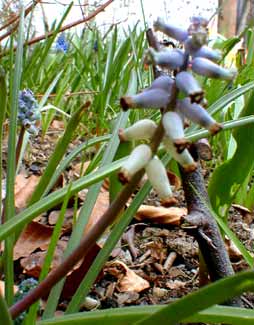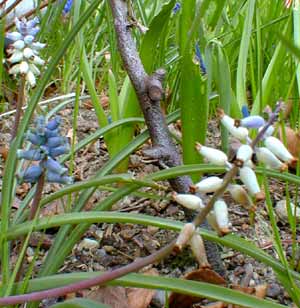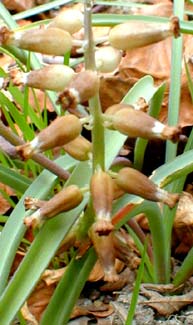
Musky Grape Hyacinth; or,
Fragrant Muscari; or,
Ambrosial Grape Hyacinth
"All close they met, all eves, before the dusk
Had taken from the stars its pleasant veil,
Close in a bower of hyacinth & musk,
Unknown of any, free from whispering tale."
-John Keats,
1795-1821
1795-1821
Muscari muscarimi (synonymous with M. ambrosiacum & M. moschatum) is the most fragrant of the grape hyacinths, with both its genus & species name referring to the musk.
The majority of Muscari species really don't have this odor, or have it so faintly you'd have to get down on your knees, give the blossom a shaking, & poke your nose right against it. By contrast, M. muscarimi is pleasingly detectable as a warm vanilla-musk from a distance. It is in fact a candidate for the best-smelling of all flowers, bar none.
This was the first Grape Hyacinth gardened in Europe. Clusius about 1554 is believed to have obtained his specimens from a garden of Constantinople. In its native range, Turkish women gathered it to include a bloom with letters to their secret lovers, its scent being associated with eroticism.
 The scape & inflorescence are usually very upright but some flowers get heavy enough to weight the stems to an angle. The scapes are a bit shorter than the recurved lances of grey-green leaves, but the leaves very generously curve away from the bloom so it is unhidden. The thin grass makes its first showing in our garden late in December, but is never so densely grassy as the autumn & winter foliage for Muscari botryoides.
The scape & inflorescence are usually very upright but some flowers get heavy enough to weight the stems to an angle. The scapes are a bit shorter than the recurved lances of grey-green leaves, but the leaves very generously curve away from the bloom so it is unhidden. The thin grass makes its first showing in our garden late in December, but is never so densely grassy as the autumn & winter foliage for Muscari botryoides.There are several color variants but few of them are named, & one just has to wait & see what shade of blue any given group of bulbs becomes. As a generality they have dulled "mat finish" colors.
Ours are typical in the maturing buds are a deep flat dark blue in a very compact raceme; then when fully open, they rapidly age into a looser & looser raceme that is pale olive-purple on top & cream to olive-yellow on the lower portion, often with a brown "pinched mouth" to each individual flower in the "grape" bunch. As they age, more of the flower becomes white. Before the whole flower whitens, it begins to turn fawn-brown, a very pretty shade quite peculiar for a flower.
Other strains can open from dark blue buds to a creamy olive-yellow for the lower portion, & pale dusty lilac for the upper portion, with lower part of the flower still apt to turn white then fawn brown.
 They stand six or eight inches tall. They can get taller but are floppier in shade. Even though they are one of the least showy of the grape hyacinths, & the least like a bunch of grapes, they making up for their small humble wild appearance by being by far the most redolent.
They stand six or eight inches tall. They can get taller but are floppier in shade. Even though they are one of the least showy of the grape hyacinths, & the least like a bunch of grapes, they making up for their small humble wild appearance by being by far the most redolent.In some gardens they wait until May to bloom, but in our garden they are in full bud by mid-March, a few are in full flower by the end of March & certainly throughout April, lingering into early May. The not-quite-fully-mature blossom shown at the top of the page is from the start of the third week of March, when most of them are not quite this far along. The same flower is shown in the second photo as it begins to fade to an increasingly creamy white, & the same bloom once more on April Fool's Day when it was fully matured to fawn. Nine-tenths of these muskies were not this far along at March's end, & the greater showing for all of them will be in April.
As heavy bloomers, grape hyacinths in general can also be heavy feeders, & will benefit from an organic fertilizer, though never anything rich. I recommend fully composted steer manure or kelp because I don't like to smear meat-products in the garden. But just as fine a response can be had using bone meal or fishmeal. Just avoid anything high in nitrogen.
Some muscaris can be a bit "weedy," in particular M. botryoides which we are happy to have naturalized in an extensive area, though some gardeners complain of such rapid spread. But some species will dwindle in numbers year by year if not kept moist & warm after dying back in summer. M. muscarimi is one that does not like to dry out in summer, so should be planted in full sun in a garden that gets at least a bit of watering through the summer, in which case it will naturalize both by self-seeding & by producing bulblets off the largish parent bulb. In regions without summers warm enough to heat dormant bulbs in the ground, it might not naturalize.
The bulbs are larger & more elongate than for other muscaris. We placed a scant three bulbs from one source just outside the dripline of a Weeping Green Beech & near a Rosy Spirea. One of these three is shown on this page as representative.
Over a dozen additional bulbs we obtained from another source, hoping to get different shades since they are potentially so varied strain to strain. These we planted at the dripline of a PJM Rhododendron where formerly there were only violets. The bulbs were a bit smaller, were planted a bit too late in the season, so their flowers were stunted small round pompoms, but otherwise healthy & should be more wonderful next year.